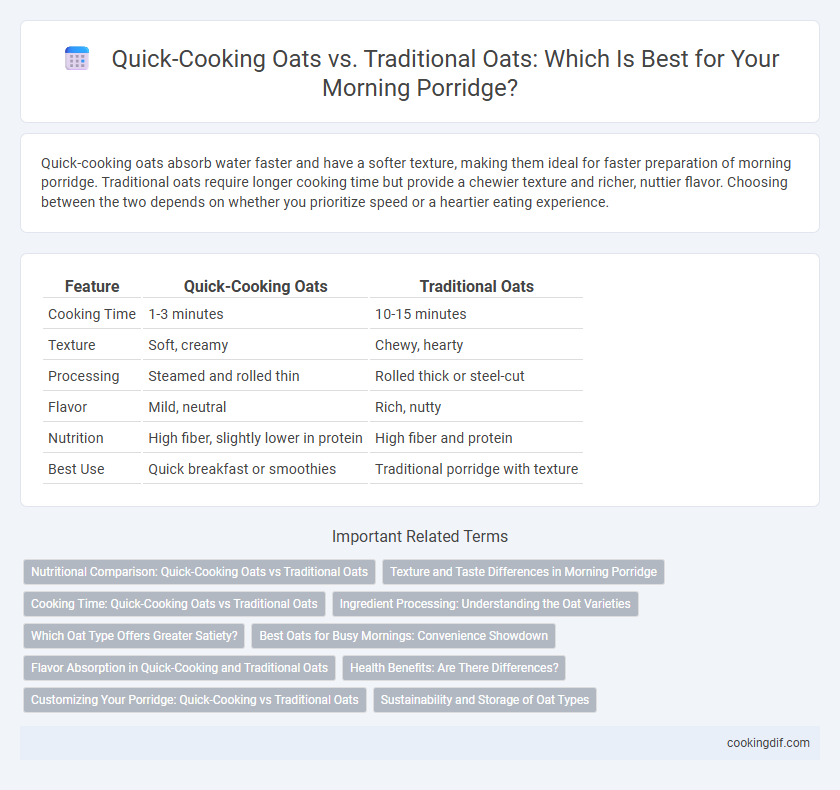Quick-cooking oats absorb water faster and have a softer texture, making them ideal for faster preparation of morning porridge. Traditional oats require longer cooking time but provide a chewier texture and richer, nuttier flavor. Choosing between the two depends on whether you prioritize speed or a heartier eating experience.
Table of Comparison
| Feature | Quick-Cooking Oats | Traditional Oats |
|---|---|---|
| Cooking Time | 1-3 minutes | 10-15 minutes |
| Texture | Soft, creamy | Chewy, hearty |
| Processing | Steamed and rolled thin | Rolled thick or steel-cut |
| Flavor | Mild, neutral | Rich, nutty |
| Nutrition | High fiber, slightly lower in protein | High fiber and protein |
| Best Use | Quick breakfast or smoothies | Traditional porridge with texture |
Nutritional Comparison: Quick-Cooking Oats vs Traditional Oats
Quick-cooking oats and traditional oats maintain similar nutritional profiles, offering high fiber, protein, and essential vitamins like B vitamins and iron. Despite quick-cooking oats being processed to reduce cooking time, their glycemic index remains comparable to traditional oats, promoting steady energy release. Both oat types provide heart-healthy beta-glucan fiber that supports cholesterol management and digestive health in morning porridge.
Texture and Taste Differences in Morning Porridge
Quick-cooking oats have a finer texture and cook rapidly, resulting in a smooth, creamy porridge with a mild oat flavor that blends easily with milk or sweeteners. Traditional oats retain a coarser texture after cooking, producing a chewier, heartier porridge with a more pronounced, nutty oat taste. The choice between quick-cooking and traditional oats impacts the porridge's mouthfeel and flavor intensity, influencing overall breakfast satisfaction.
Cooking Time: Quick-Cooking Oats vs Traditional Oats
Quick-cooking oats typically require 1 to 3 minutes of cooking time, making them ideal for fast or on-the-go breakfasts. Traditional oats, also known as old-fashioned rolled oats, generally need about 5 to 10 minutes to cook, offering a thicker, chewier texture. The shorter cooking time of quick-cooking oats results from their finer cut and thinner flakes, which absorb water more rapidly than the larger flakes of traditional oats.
Ingredient Processing: Understanding the Oat Varieties
Quick-cooking oats undergo extensive steaming and rolling to reduce cooking time, resulting in a finer texture that absorbs liquid rapidly for a creamy porridge. Traditional oats, also known as old-fashioned oats, are steamed and rolled with less processing, preserving a thicker, chewier texture that retains more nutrients during cooking. The ingredient processing differences directly affect cooking duration, porridge consistency, and the glycemic index, influencing energy release and digestion speed.
Which Oat Type Offers Greater Satiety?
Quick-cooking oats digest faster than traditional oats, resulting in a quicker rise in blood sugar but shorter-lasting fullness. Traditional oats, with their intact oat groat structure and higher fiber content, provide a slower digestion process that promotes sustained satiety. Studies indicate that the beta-glucan fiber in traditional oats enhances feelings of fullness longer, making them a better choice for prolonged morning satiety.
Best Oats for Busy Mornings: Convenience Showdown
Quick-cooking oats offer a significant time advantage, absorbing water more rapidly due to their finer cut and steaming process, making them ideal for busy mornings when speed is essential. Traditional oats retain more texture and nutrient density, requiring longer cooking times but providing a heartier porridge experience. Choosing between quick-cooking and traditional oats depends on whether convenience or texture and nutrition rank higher for your morning routine.
Flavor Absorption in Quick-Cooking and Traditional Oats
Quick-cooking oats absorb flavors more rapidly due to their finely processed, thinner texture, allowing for faster infusion of spices, sweeteners, and fruits during cooking. Traditional oats, with their thicker and less processed flakes, provide a slow, gradual flavor absorption that enhances a hearty and textured porridge experience. This distinction makes quick-cooking oats ideal for quick, flavorful meals while traditional oats deliver richer, deeper-tasting porridge.
Health Benefits: Are There Differences?
Quick-cooking oats and traditional oats both offer significant health benefits, including high fiber content that supports digestive health and helps regulate blood sugar levels. Traditional oats retain more of their bran and germ, providing slightly higher amounts of vitamins and minerals such as magnesium and iron. Quick-cooking oats, while processed to cook faster, still contain beta-glucan, a soluble fiber known to lower cholesterol and improve heart health.
Customizing Your Porridge: Quick-Cooking vs Traditional Oats
Quick-cooking oats offer a faster preparation time, making them ideal for a quick, smooth-textured porridge, while traditional oats provide a heartier, chewier consistency that retains more nutrients due to minimal processing. Choosing between quick-cooking and traditional oats depends on personal preference for texture and cooking time, with traditional oats often preferred for their richer flavor and enhanced satiety. Adjusting liquid ratios and cooking durations allows customization, enabling a creamy or thick porridge base tailored to individual taste and dietary needs.
Sustainability and Storage of Oat Types
Quick-cooking oats require less processing and lower energy inputs compared to traditional oats, enhancing their sustainability profile. Both oat types have similar shelf lives when stored in airtight containers in cool, dry conditions, but traditional oats maintain optimal freshness longer due to their less processed state. Choosing sustainable sourcing practices for either type further minimizes environmental impact while ensuring nutritious porridge options.
Quick-cooking oats vs Traditional oats for morning porridge Infographic

 cookingdif.com
cookingdif.com